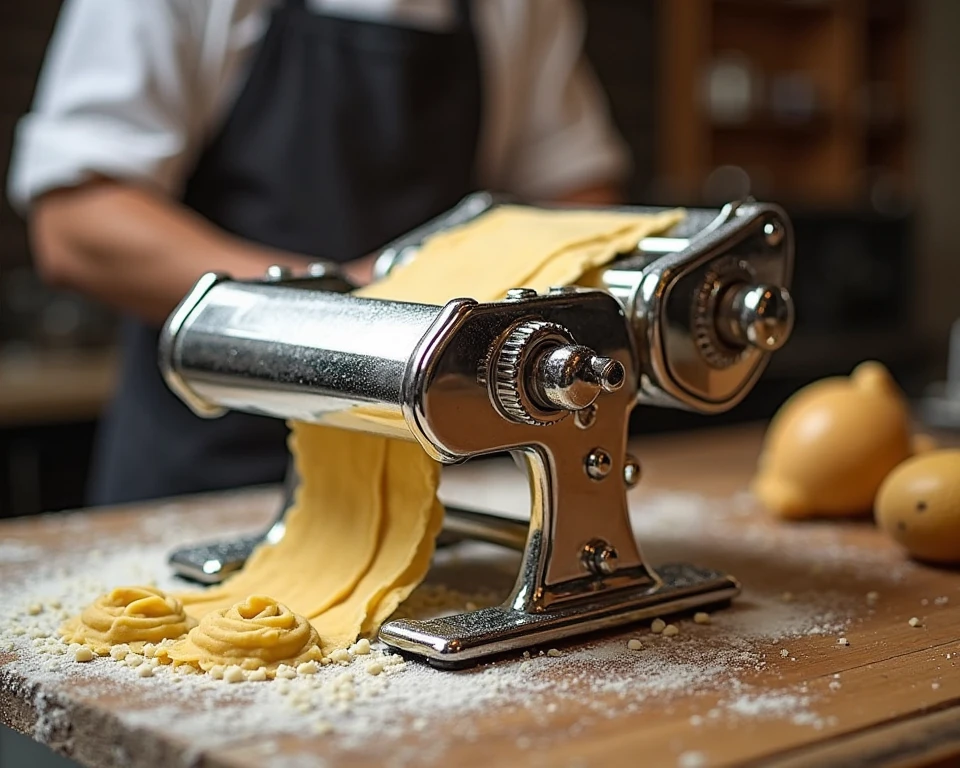1. Introduction: What Is a Tortellinatrice?
The word “tortellinatrice” comes from Italian, blending “tortellini” (the traditional stuffed pasta) with the suffix “-atrice,” which denotes a machine or device. Thus, a tortellinatrice is a specialized machine designed to automate the process of making tortellini. These machines streamline the pasta-making workflow, from feeding dough to shaping and stuffing tortellini, ensuring consistent size and quality.
There are different types of tortellinatrici: manual, semi-automatic, and industrial. Manual machines require human effort and are ideal for home or small business use. Semi-automatic machines offer partial automation, speeding up the process while allowing for artisanal control. Fully automatic or industrial models are designed for high-volume production, capable of producing thousands of tortellini per hour.
2. A Brief History of Tortellini and the Evolution of the Tortellinatrice
Tortellini originated in the Emilia-Romagna region of Italy, particularly Bologna and Modena. The pasta’s shape is inspired by local legends, including one myth involving the Roman goddess Venus. Traditionally, tortellini were made by hand, a labor-intensive process involving delicate dough, precise filling, and careful folding.
With increased demand and globalization, pasta makers began seeking efficient production methods. Thus, the tortellinatrice was born, evolving from basic mechanical devices to sophisticated digital machines. Today, this evolution ensures both the preservation of Italian culinary heritage and the scalability required by modern food industries.
3. How Does a Tortellinatrice Work?
A tortellinatrice typically includes several core components: a dough feeder, a filling injector, a cutter, and a forming mechanism. Dough sheets are fed into the machine, followed by the injection of filling. Then, the machine cuts and folds the dough into tortellini shapes using precision molds.
The step-by-step process generally looks like this:
- Dough sheets are loaded or rolled out.
- Filling is automatically dispensed in measured amounts.
- The cutter creates the base shape.
- The forming mechanism folds and seals each tortellino.
This workflow ensures uniformity and significantly reduces manual labor while maintaining artisanal quality in higher-end models.
4. Types of Tortellinatrici: Which One Fits Your Needs?
Manual models are compact and ideal for home cooks or small-scale operations. They require hand-cranking and manual placement of dough and filling.
Semi-automatic machines offer motorized components like rollers or injectors but still need some user intervention, making them suitable for small pasta shops.
Fully automatic machines are perfect for large-scale production, capable of operating with minimal supervision and producing thousands of tortellini per hour. These are often used in industrial food manufacturing.
Each type has its pros and cons. Manual models are affordable and great for artisanal quality but slower. Semi-automatics offer a good balance, while industrial machines deliver speed and efficiency at a higher cost.
5. Key Features to Look for in a Quality Tortellinatrice
When shopping for a tortellinatrice, prioritize these features:
- Materials: Stainless steel offers durability and hygiene, while food-grade plastic parts can reduce weight.
- Customization: Some machines allow interchangeable molds for different sizes and shapes.
- Speed and Capacity: Match the machine’s output with your production needs.
- Ease of Maintenance: Detachable parts simplify cleaning and extend machine life.
- Safety: Look for CE certification, emergency stops, and overload protection.
These features impact not only performance but also the machine’s lifespan and operational safety.
6. Top Brands and Manufacturers of Tortellinatrici
Italy leads the market with top-tier brands such as:
- La Monferrina: Known for both artisan and industrial pasta machines.
- Imperia & Monferrina: Offers manual and electric options.
- Bottene: Specializes in semi-automatic and professional models.
Premium brands are distinguished by superior engineering, durable materials, and better support. When comparing models, consider dimensions, power usage, mold compatibility, and price. Prices can range from $300 for manual machines to over $15,000 for industrial models.
7. Buying Guide: Where and How to Purchase a Tortellinatrice
Buyers can find tortellinatrici from:
- Online platforms like Amazon and Alibaba.
- Specialty kitchen equipment retailers.
- Direct from manufacturers for professional-grade machines.
When buying online, check verified reviews and warranty details. In-store purchases allow hands-on inspection. For used machines, inspect for wear, motor function, and part availability.
8. Maintenance Tips and Troubleshooting Common Issues
Routine maintenance is key. Clean after each use, especially the filling injector and forming molds. Lubricate moving parts as per the manufacturer’s guidelines.
Common issues include:
- Jamming: Often caused by thick dough or excessive filling.
- Leaking: Resulting from misaligned parts or dried fillings.
- Poor shaping: May indicate worn molds or incorrect settings.
Keep spare parts like belts, injectors, and molds on hand. Many manufacturers offer servicing or customer support for troubleshooting.
9. How to Use a Tortellinatrice: Beginner’s Guide
For beginners, using a tortellinatrice starts with choosing the right dough consistency (firm yet pliable) and a smooth, moist filling.
Step-by-step:
- Prepare dough sheets and filling.
- Preheat or calibrate the machine if needed.
- Feed the dough and loading filling trays.
- Turn the handle or activate the motor.
- Collect the tortellini from the output tray.
Tips:
- Use flour to prevent dough sticking.
- Avoid overfilling to prevent tearing.
- Always unplug before cleaning or adjusting.
10. Tortellini Recipes to Try with Your Tortellinatrice
Start with classic meat tortellini made with pork, prosciutto, and parmesan. For vegetarians, try fillings like spinach-ricotta or mushroom truffle.
Creative options include:
- Pumpkin-sage tortellini
- Seafood-stuffed tortellini
- Sweet tortellini with ricotta and chocolate or fruits for dessert pasta.
Experimenting with flavors can turn your tortellinatrice into a versatile culinary tool.
11. Benefits of Using a Tortellinatrice in Commercial Kitchens
For restaurants and pasta shops, a tortellinatrice:
- Saves time and labor costs.
- Ensures uniform size and filling consistency.
- Allows fast response to customer demand.
It also enables greater menu flexibility and creative pasta offerings, all while maintaining production efficiency.
12. Future Innovations in Tortellinatrice Technology
New models are integrating IoT connectivity, allowing remote monitoring and recipe programming. Energy-efficient motors and recyclable components are reducing environmental impact.
Some startups are even experimenting with 3D-printed pasta shapes and AI-assisted customization, promising even more advanced applications.
13. FAQs About Tortellinatrici
- Can I use it for other pasta types? Some machines can make ravioli or cappelletti with proper molds.
- How much does it cost? Manual models start at $300, semi-automatics range from $2,000–$5,000, and industrial versions exceed $10,000.
- Is it suitable for home use? Yes, especially manual or small electric versions.
- How do I clean the filling injector? Detach and soak it in warm soapy water, use a brush for residue, then dry thoroughly.
14. Conclusion: Why Every Pasta Lover or Business Should Consider a Tortellinatrice
A tortellinatrice transforms how tortellini is made—boosting efficiency, ensuring consistency, and enabling culinary innovation. Whether you’re a home chef or commercial pasta producer, investing in the right machine can elevate both productivity and quality.

